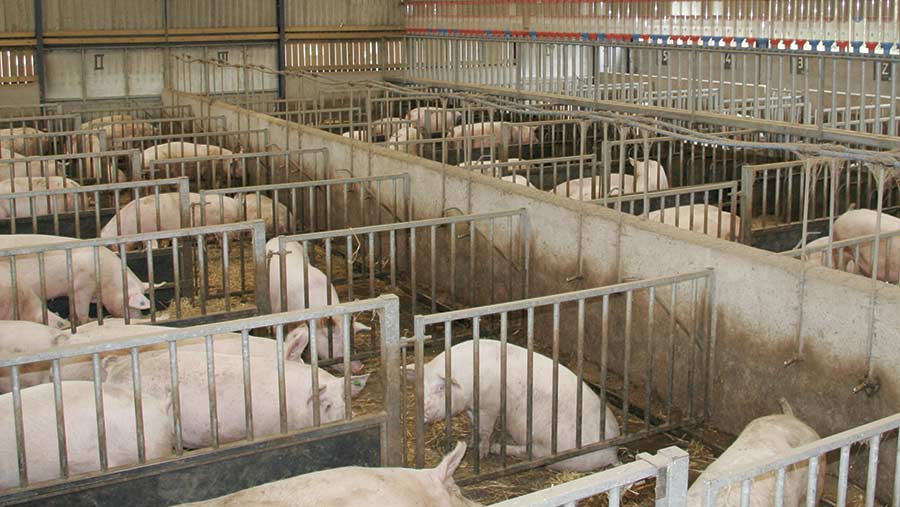Q&A: How new environmental pig permits could affect you
 © Tim Scrivener
© Tim Scrivener Pig farms operating with an environmental permit, or farms planning on expanding, could be affected by new limits on the levels of ammonia, phosphorous and nitrogen they can emit.
Sarah Alderton gets the low-down on the new rules from AHDB Pork’s Emma Slater.
What is an environmental permit and who needs one?
An environmental permit is permission to operate and is issued by the Environment Agency (EA) across a range of industries.
Only pig farms over a certain size need a permit. Anyone who has places for either 2,000-plus finishing pigs over 30kg or 750 sows (including served gilts) needs a permit.
If you are planning to expand and think you might need one, contact the EA’s farming team, as failure to operate without a permit is a criminal offence.
See also: Advice for controlling PRRS in pigs
Most pig and poultry permits are bespoke for the farm or unit they relate to and highlight environmental standards and emissions limits which the farm must adhere to. Permits are only required for indoor pig units.
Operating with a permit is not much more work than what is required for many assurance schemes.
What are the main changes being made to environmental permits?
The EA has to review all existing permits and issue a new permit consistent with the new European Commission reference document within the next four years (by February 2021).
In the main, not much has changed.
However, the big difference is now there is a limit on the levels of ammonia, phosphorous and nitrogen permitted farms can emit.
These are published in a document called the Best Available Techniques reference document and a Best Available Techniques conclusions document. These were updated and published in February 2017 on the EU web page Intensive Rearing of Poultry or Pigs.
These new emission levels are called best available technique associated emission levels (BAT AELS).
How will the emission levels on be calculated on farms?
Ammonia levels will be calculated using standard emissions factors, derived from historical data. It will be based on the age category of pigs, building type and management system.
For example, an indoor finishing unit that is fully slatted will have a different ammonia level compared with a part-slatted system.
Ammonia emissions will be calculated on a per building basis so each building, old or new, will need to meet the limits set.
Levels of nitrogen and phosphorous will be determined by the physical performance on farm. For example, if feed use and productivity is good this helps minimise the excretion of surplus nitrogen and phosphorous and, as a result, reduces potential pollution to the environment.
It is anticipated producers will be able to calculate their emissions using an online calculator, which will require them to input information about their individual farm.
This will calculate the quantity of nutrients excreted to check compliance in a quick and simple way. It is being developed by AHDB Pork along with the Agricultural Industries Federation (AIC). It is hoped this will be available by the end of the year.
However, there are alternative methods to calculate excretion levels. Your nutritionist or feed company may be able to help you with this and it is advisable you contact them.
When do I have to meet these BAT AELs?
Farms with a permit or those applying for a permit will have to comply with these new emissions limits for existing and new buildings as soon as the new permit is issued. This process will be completed by February 2021.
What do I need to do now?
To start the review process, all permitted farms should receive a questionnaire from the EA shortly. This will be used to see whether your permits comply with the new standards and identify what improvements may be necessary.
What happens if I don’t meet the new emission levels?
If you need to make changes or have any concerns, AHDB Pork can talk these through with you and help you to identify solutions. AHDB is working on guidance and other resources to help explain these changes in a practical way.
The standards for existing buildings may be slightly different to those for new buildings, however, all will have to be compliant. The first thing to do is to take stock, stand back and look at everything rationally in a systematic manner.
How can altering feed reduce N and P excretion levels?
There are various ways that feeding regime and types of feed can help to reduce phosphorous and nitrogen excretion. These are best discussed on a case-by-case basis with your nutritionist.
- Nutritionists may look at things such as:
- Multiphase feeding – whereby a nutritional programme is implemented according to individual pigs ages
- Addition of controlled amount of essential amino acids
- Use of authorised feed additives for example, supplementary amino acids and phytase
What changes can I make to my pig housing to help reduce ammonia emissions?
For ammonia emissions, you can focus on feeding regimes, type of pen floor, slurry and manure management and, if all else fails, end of pipe measures such as air cleaners.
|
Practical measures that can help reduce ammonia levels |
|
|
Focus area |
Details |
|
Solid floor system |
Differentiated lying and dunging areas |
|
Slurry removal |
A vacuum system (plugged or sluiced slurry pits) for frequent slurry removal
|
|
Slurry removal |
Using a scraper for frequent slurry removal |
|
Floor type manure |
Having part slatted floors compared with fully slatted floors or changing the slat beam to slot width ratio (for example, solid draining floors versus fully slatted) |
|
Reduced manure surface area |
Ammonia emissions can be reduced by reducing the manure surface area, for example, in farrowing accommodation using a solid floor with a narrow slurry pit or dividing the area beneath the pen into two sections |
|
pH reduction in slurry/manure |
Sulphuric acid is added to slurry in order to lower the ph to about 5.5 in the slurry pit. This increases the fertiliser value of slurry and can reduce odour. |
|
Slurry cooling |
Reducing slurry temperature by using a system of cooling pipes set in the slurry pit floor connected to a heat pump (the opposite to underfloor heating). This gives the opportunity to recover heat and use it elsewhere. |
|
End of pipe measures |
These are typically air cleaning systems, often referred to as scrubbers. There are a number of types including chemical, acid and biological processes, the choice of which is very site specific. |
Industry reaction
For many pig farmers with permitted sites, news about limits on the levels of ammonia, phosphorous and nitrogen will come as a surprise.

Steve Hart © Tim Scrivener
Steve Hart, Norfolk Free Range, Norfolk
- 13,000 outdoor sows
- 75,000 growing pigs
“We currently have an IPPC permit but are not aware of any retrospective changes.
“We did hear about some changes, but it was implied these were only for new installations.
“We have had no paperwork about it at all.”

Andrew McCrea © Steffan Hill
Andrew McCrea, Northern Ireland
- 900 sows
- 24,000 finishers
“We have heard nothing yet, but have got an IPPC inspection in October/November time.
“We have already done some work on emissions and have proven by changing a few things, such as adding phytase enzymes to the ration and reducing phosphorous in the ration, you can reduce emissions.
“We have also moved some finishers to another site, which has allowed us to increase sow numbers.”
Zoe Davies, National Pig Association

Zoe Davies
“About 210 environmental permits were in place at the end of 2016.
“The big issue is the additional charging the Environment Agency plan to bring in, which will not be popular in addition to the Associated Emission Levels people will now have to meet for ammonia, nitrogen and phosphorous per building, which will affect quite a few I should imagine.
“So, the major initial issue here will be retaining existing permits.”

